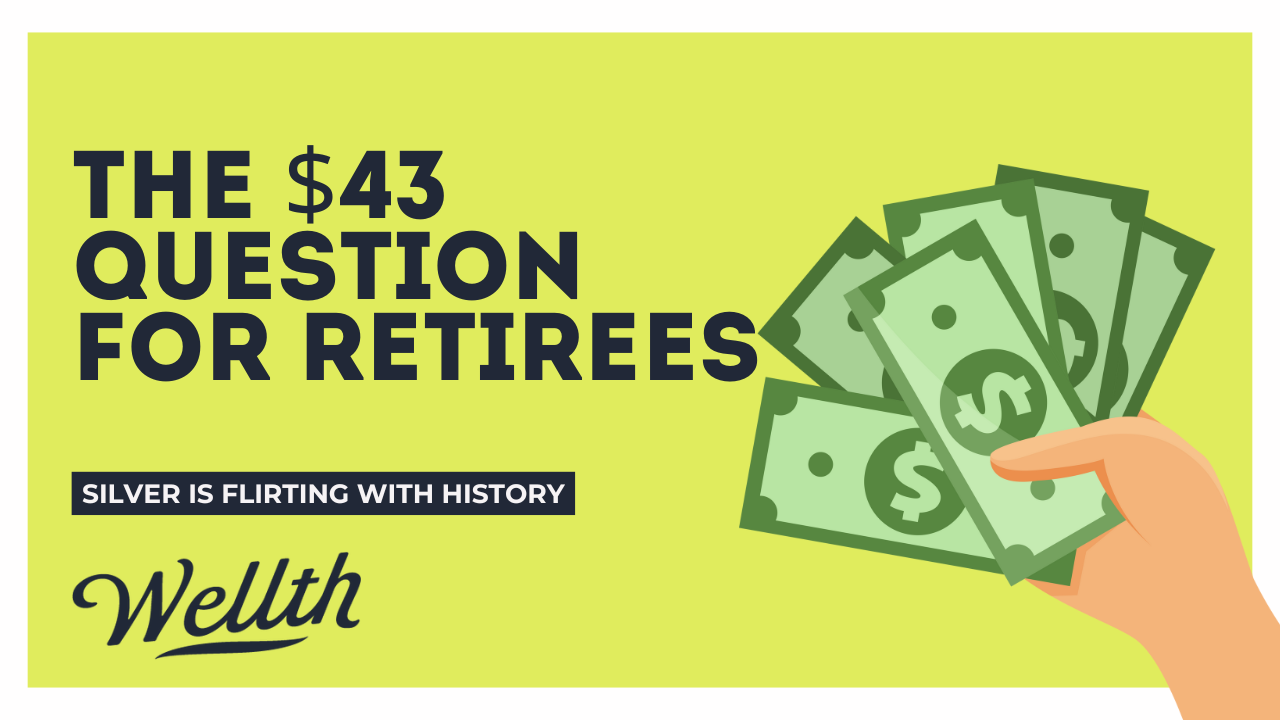The $43 Question for Retirees
With silver brushing against its all-time peak, the real decision isn’t when to sell — it’s why you should still hold.
Silver is flirting with history. At roughly $43 an ounce, the white metal is only a few dollars shy of its all-time high of $49.95, set back on January 17, 1980.
For a generation of investors, that number has loomed like a mountain peak that might never be scaled again. Now, with silver closing in, the question arises: should it have a place in your retirement portfolio?
Our view: yes but not as a speculative bet. Silver, like gold, should be seen as an insurance policy. In small doses — 2% to 5% of a portfolio — it can protect retirees from the risks that no one can time or predict.
1. Guarding Against Inflation
Retirement often stretches decades. Over that span, even modest inflation can quietly erode purchasing power. Silver and gold are among the few assets with a centuries-long record of keeping pace. While the dollar loses value, metals tend to rise — sometimes unevenly, but decisively over the long arc of history.
Since 2000, gold prices increased from $270 per ounce to $3,723, while silver has increased from $4.95 per ounce to $43.64. Both have significantly outpaced estimated inflation of 85% over the same time period.
2. Diversification That Matters
Most portfolios lean on the balance between stocks and bonds. But in 2022, both pillars cracked — the S&P 500 dropped 19%, and the Bloomberg U.S. Aggregate Bond Index sank 13%, its worst year on record. Gold, by contrast, finished the year almost flat (down just 0.3%), and silver managed a modest 2% gain after a late rally. Neither metal soared, but they did what insurance is supposed to do: hold steady when everything else is falling. For retirees, that kind of anchor can make the difference between weathering a storm and being forced to sell core holdings at the worst possible time.
3. Crisis Insurance You Hope Not to Use
Markets don’t just move on earnings and interest rates. They lurch on wars, bank failures, currency crises, and policy mistakes. Retirees, more than any group, need assets that can weather such shocks. Silver’s track record as a safe-haven isn’t perfect, it’s volatile, more industrial than gold but in moments of deep market stress, it often plays defense when other assets can’t.
4. Growth Potential Beyond Gold
Silver carries a trait gold lacks: industrial demand. From solar panels to electronics, the white metal has utility in the modern economy. That dual role — store of value and essential input — adds a long-term growth dimension. It doesn’t mean prices will climb in a straight line, but it does mean silver’s story isn’t only about inflation and fear.
A Modest Slice, A Big Difference
None of this suggests retirees should rush to load up on bullion.
Silver is volatile. Its price can swing 20% in months. That’s why the allocation should stay small — 2% to 5% of the total portfolio. The role is not to drive returns but to protect them. Insurance policies, after all, aren’t meant to make you rich. They’re meant to keep you from going broke.
With silver pressing against highs not seen since the Carter administration, the temptation is to think the easy money has been made.
But that misses the point. For retirees, precious metals aren’t about chasing peaks. They’re about ensuring that, when the peaks turn to valleys elsewhere in the portfolio, you’ve got something solid in reserve.
Disclaimer: This analysis is for informational purposes only and does not constitute financial advice. Investors should conduct their own due diligence and consult with a financial advisor before making investment decisions.


